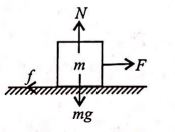Q. A block of mass $2\, kg$ initially at rest moves under the action of an applied horizontal force of $6\, N$ on a rough horizontal surface. The coefficient of friction between block and surface is $0.1$. The work done by the applied force in $10\, s$ is (Take $g = 10\, ms^{-2}$)
Work, Energy and Power
Solution:
